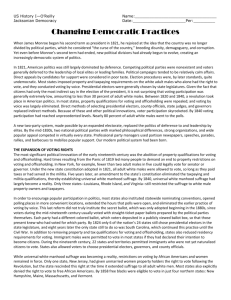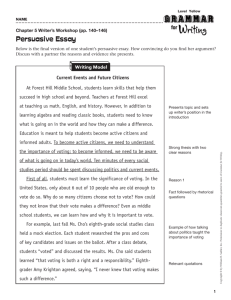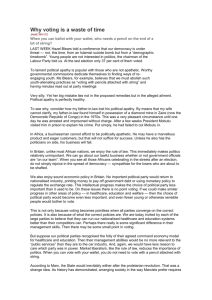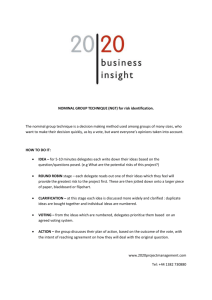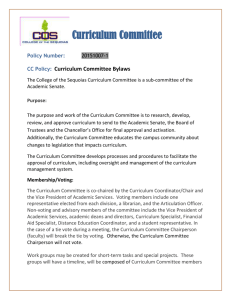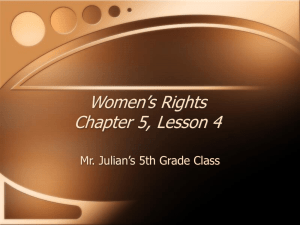AP US History The Rise of Democratic Politics When James Monroe
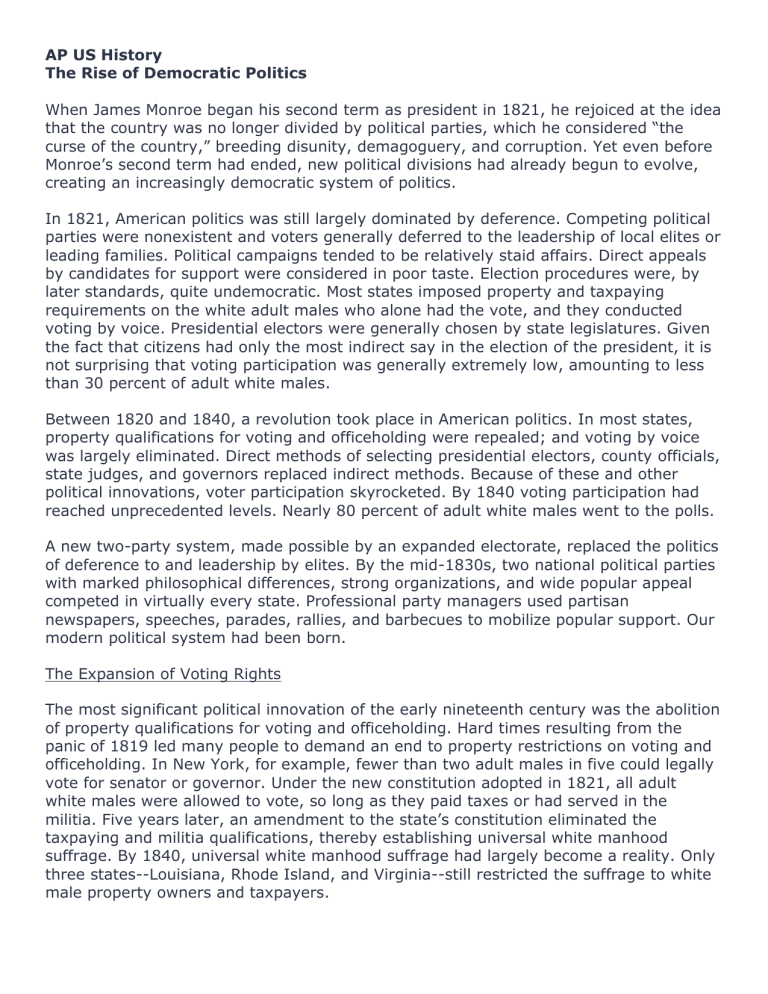
AP US History
The Rise of Democratic Politics
When James Monroe began his second term as president in 1821, he rejoiced at the idea that the country was no longer divided by political parties, which he considered “the curse of the country,” breeding disunity, demagoguery, and corruption. Yet even before
Monroe’s second term had ended, new political divisions had already begun to evolve, creating an increasingly democratic system of politics.
In 1821, American politics was still largely dominated by deference. Competing political parties were nonexistent and voters generally deferred to the leadership of local elites or leading families. Political campaigns tended to be relatively staid affairs. Direct appeals by candidates for support were considered in poor taste. Election procedures were, by later standards, quite undemocratic. Most states imposed property and taxpaying requirements on the white adult males who alone had the vote, and they conducted voting by voice. Presidential electors were generally chosen by state legislatures. Given the fact that citizens had only the most indirect say in the election of the president, it is not surprising that voting participation was generally extremely low, amounting to less than 30 percent of adult white males.
Between 1820 and 1840, a revolution took place in American politics. In most states, property qualifications for voting and officeholding were repealed; and voting by voice was largely eliminated. Direct methods of selecting presidential electors, county officials, state judges, and governors replaced indirect methods. Because of these and other political innovations, voter participation skyrocketed. By 1840 voting participation had reached unprecedented levels. Nearly 80 percent of adult white males went to the polls.
A new two-party system, made possible by an expanded electorate, replaced the politics of deference to and leadership by elites. By the mid-1830s, two national political parties with marked philosophical differences, strong organizations, and wide popular appeal competed in virtually every state. Professional party managers used partisan newspapers, speeches, parades, rallies, and barbecues to mobilize popular support. Our modern political system had been born.
The Expansion of Voting Rights
The most significant political innovation of the early nineteenth century was the abolition of property qualifications for voting and officeholding. Hard times resulting from the panic of 1819 led many people to demand an end to property restrictions on voting and officeholding. In New York, for example, fewer than two adult males in five could legally vote for senator or governor. Under the new constitution adopted in 1821, all adult white males were allowed to vote, so long as they paid taxes or had served in the militia. Five years later, an amendment to the state’s constitution eliminated the taxpaying and militia qualifications, thereby establishing universal white manhood suffrage. By 1840, universal white manhood suffrage had largely become a reality. Only three states--Louisiana, Rhode Island, and Virginia--still restricted the suffrage to white male property owners and taxpayers.
In order to encourage popular participation in politics, most states also instituted statewide nominating conventions, opened polling places in more convenient locations, extended the hours that polls were open, and eliminated the earlier practice of voting by voice. This last reform did not truly institute the secret ballot, which was only adopted beginning in the 1880s, since voters during the mid-nineteenth century usually voted with straight-ticket paper ballots prepared by the political parties themselves. Each party had a different colored ballot, which voters deposited in a publicly viewed ballot box, so that those present knew who had voted for which party. By 1824 only 6 of the nation’s
24 states still chose presidential electors in the state legislature, and eight years later the only state still to do so was South Carolina, which continued this practice until the
Civil War. In addition to removing property and tax qualifications for voting and officeholding, states also reduced residency requirements for voting. Immigrant males were permitted to vote in most states if they had declared their intention to become citizens. During the nineteenth century, 22 states and territories permitted immigrants who were not yet naturalized citizens to vote. States also allowed voters to choose presidential electors, governors, and county officials.
While universal white manhood suffrage was becoming a reality, restrictions on voting by African Americans and women remained in force. Only one state, New Jersey, had given unmarried women property holders the right to vote following the Revolution, but the state rescinded this right at the time it extended suffrage to all adult white men.
Most states also explicitly denied the right to vote to free African Americans. By 1858 free blacks were eligible to vote in just four northern states: New Hampshire, Maine,
Massachusetts, and Vermont.
Popular Attacks on Privilege
The democratic impulse that swept the country in the 1820s was also apparent in widespread attacks on special privilege and aristocratic pretension. Established churches, the bench, and the legal and medical professions all saw their elitist status diminished.
The judiciary became more responsive to public opinion through election, rather than appointment, of judges. To open up the legal profession, many states dropped formal training requirements to practice law. Some states also abolished training and licensing requirements for physicians, allowing unorthodox “herb and root” doctors, including many women, to compete freely with established physicians.
The surge of democratic sentiment had an important political consequence: the breakdown of the politics of deference and its terminology. The eighteenth-century language of politics--which included such terms as “faction,” “junto,” and “caucus”--was rooted in an elite-dominated political order. During the first quarter of the nineteenth century, a new democratic political vocabulary emerged that drew its words from everyday language. Instead of “standing” for public office, candidates “ran” for office.
Politicians “log-rolled” (made deals) or “straddled the fence” or promoted “pork barrel” legislation (programs that would benefit their constituents).
During the first quarter of the nineteenth century, local elites lost much of their influence. They were replaced by professional politicians. In the 1820s, political
innovators such as Martin Van Buren, the son of a tavernkeeper, and Thurlow Weed, a newspaper editor in Albany, New York, devised new campaign tools such as torchlight parades, subsidized partisan newspapers, and nominating conventions. These political bosses and manipulators soon discovered that the most successful technique for arousing popular interest in politics was to attack a privileged group or institution that had used political influence to attain power or profit.
The “Anti-Masonic party” was the first political movement to win widespread popular following using this technique. In the mid-1820s, a growing number of people in New
York and surrounding states had come to believe that members of the fraternal order of
Freemasons, who seemed to monopolize many of the region’s most prestigious political offices and business positions, had used their connections to enrich themselves. They noted, for instance, that Masons held 22 of the nation’s 24 governorships.
Then, in 1826, in the small town of Batavia, New York, William Morgan, a former Mason, disappeared. Morgan had written an exposé of the organization in violation of the order’s vow of silence, and rumor soon spread that he had been tied up with heavy cables and dumped into the Niagara River. When no indictments were brought against the alleged perpetrators of Morgan’s kidnapping and presumed murder, many upstate New Yorkers accused local constables, justices of the peace, and judges, who were members of the
Masons, of obstruction of justice.
By 1830 the Anti-Mason movement had succeeded in capturing half the vote in New
York State and had gained substantial support throughout New England. In the mid-
1830s, the Anti-Masons were absorbed into a new national political party, the Whigs.
Copyright: Digital History, 2013
